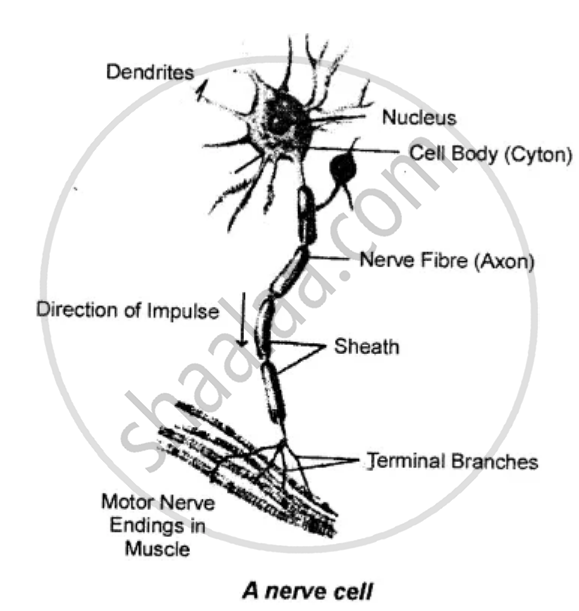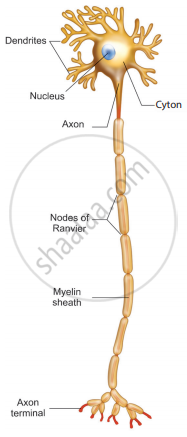Advertisements
Advertisements
प्रश्न
With the help of a suitable diagram describe the structure of a neuron.
उत्तर १

Nervous system consists of special cells called nerve cells or neurons. It has a main cell body called cyton. It gives out many processes called dendrites. From it, a very long process is given out. It is called axon or nerve fiber.
The cell body has a nucleus. The dendrites get the message from the organs and send this message to the axon through the cell body. Then the axon sends the message to muscles to contract or to the gland for secretion.
The neurons make contact with one another through their processes. The axon at its end branches and meets the dendrites of another neuron. The meeting point is called a synapse. The message is passed on from one axon to the dendrites of another neuron. How the message goes? It is like this:
Organ → Message goes to dendrites →Cell body → Axon → Muscles or glands
उत्तर २

Structure of Neuron
Structure of Neuron: A neuron consists of three basic parts namely Cyton, Dendrites, and Axon.
(a) Cyton: Cyton is called cell body or perikaryon. It has a central nucleus with abundant cytoplasm called neuroplasm. The cytoplasm has a large granular body called Nissl’s granules and other cell organelles like mitochondria, ribosomes, lysosomes, and endoplasmic reticulum. Neurons do not have the ability to divide. Several neurofibrils are present in the cytoplasm that help in the transmission of nerve impulses to and from the cell body.
(b) Dendrites: These are the numerous branched cytoplasmic processes, that project from the surface of the cell body. They conduct nerve impulses, towards the cyton. The branched projections increase the surface area for receiving signals from other nerve cells.
(c) Axon: The axon is a single, elongated, slender projection. The end of the axon terminates as fine branches, which terminate into knob-like swellings called synaptic knob.
The plasma membrane of the axon is called axolemma, while the cytoplasm is called axoplasm. It carries impulses away from the cyton. The axons may be covered by a protein sheath called the myelin sheath, which is further covered by a layer of Schwann cells called neurilemma.
Myelin sheath breaks at intervals, by depressions called Nodes of Ranvier. The region between the nodes is called an internode. Myelin sheath acts as an insulator and ensures the rapid transmission of nerve impulses.
A junction between the synaptic knob of the axon of one neuron and the dendron of the next neuron is called Synaptic Junction. Information from one neuron can pass to another neuron through these junctions, with the release of chemicals known as neurotransmitters, from the synaptic knob.
संबंधित प्रश्न
What are the short fibres of a neuron known as?
Fill in the following blank with suitable word :
The neuron which carries a message for action to a muscle or gland is known as a......... neuron.
Name the three types of nerves which constitute the peripheral nervous system.
What is the function of receptors and effectors in our body?
What is the function of our nervous system?
The organ A which is located inside the skull of our body is protected by a bony shell B. It is surrounded by three layers membranes C. The spaces between these layers are filled with a liquid D which protects organ A from mechanical shocks. Organ A in combination with another organ E makes up the central nervous system.
(a) What is organ A?
(b) What are B, C and D?
(c) Name the organ E.
(d) While walking barefoot, if we happen to step on a sharp piece of stone, we immediately lift our foot up. Which of the two organs: A or E, is directly involved in this action?
(e) If we step out from a darkened room into bright sunlight, we close our eyes for a moment. Which of the two organs: A or E, is directly involved in this action?
State whether the following statement is true (T) or false (F):
Retina is present on the outer surface of the eye.
Fill in the blank:
Basic structural unit of the nervous system is the ..................
Fill in the blank:
Peripheral nervous system consists of ...................
Distinguish between the following pair of words:
Nervous system and hormonal system
Where is this located?
Nodes of Ranvier
Plants do not have any nervous system but yet, if we touch a sensitive plant, some observable changes take place in its leaves. Explain how could this plant respond to the external stimuli and how it is communicated.
What are thermoreceptors?
Explain the Term: Ganglion
Complete the following sentence with appropriate word :
Optic nerve is a type Sensory nerve, whereas spinal nerves are __________ nerves
List out the functions of Endocrine system and Nervous system.
Which of the following is NOT a part of forebrain?
Visceral nervous system comprises of ______.
How is an electric impulse created in human nervous system?
